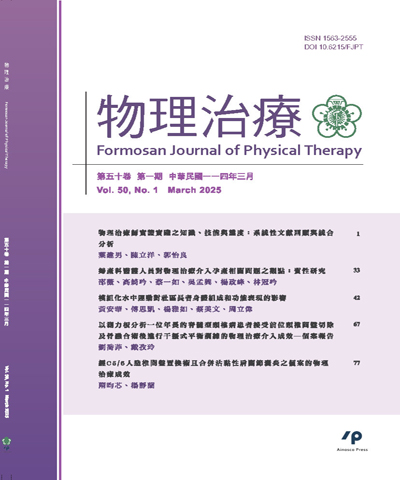
物理治療/Formosan Journal of Physical Therapy
社團法人臺灣物理治療學會 & Ainosco Press,正常發行
選擇卷期
- 期刊
Background and Purpose: Klinefelter syndrome (KS) is a condition that affects males with an additional-X chromosome. Motor delays and motor skill deficits were observed in the boys with KS. The purpose of this report was to examine the outcomes of physical therapy service for a child with KS according to the International Classification of Functioning, Disability and Health for Children and Youth (ICF-CY) framework. Methods: A 5-year-old boy was diagnosed with KS and global developmental delay. We designed the shaoguan game as the treatment strategy, include hopping and throwing a tennis ball. Peabody Developmental Motor Scales 2nd Edition (PDMS-2) was used to evaluate the developments of gross motor and fine motor as the primary outcome. Results: The gross motor quotient (GMQ) of PDMS-2 was improved from 87 to 89. Progressive report of PDMS-2 showed improvements about items of "object manipulation," throwing tennis ball overhand and underhand at least 10 ft. (d445), and attention for 20-30 min (b140), as well as items of "locomotion," hopping forward on one foot for four hops (d4553). However, his mother reflected the lack of family support (e310). Conclusion: This individualized physical therapy service improved the performances of "object manipulation," "locomotion," and attention for a child with KS. Clinical Relevance: The case report supports the importance of clinical relevance outcome measures and proper follow-ups.
- 期刊
背景與目的:適應體育是一門綜合科學,整合特殊教育、醫學、教育學、心理學、社會學等學科,透過評估進而診斷與解決因失能而引起的社會、情意、認知與心理動作等方面的終身問題。研究利用適應體育概念,設計體能訓練進階活動達成功能性之目標,並藉由腦性麻痺兒童身體各項之差異,編製一套適應體育體能訓練活動方案,透過實際操作體能訓練活動方案,瞭解腦性麻痺兒童在學校體育活動上會面臨何種不同形式上的困難與是否能運用此活動方案轉換到各種情境。方法:研究對象為一名國小腦性麻痺兒童,粗大功能性動作介於粗大動作功能分類系統(Gross Motor Function Classification System)Level I、II、功能性運動分類於第六、七等級。需在六個月內無施打肉毒桿菌毒素、酚劑、脊膜內藥物注射,及吃肌肉鬆弛劑藥物等,並無任何手術治療介入。研究採取單一個案研究法之倒返實驗設計(A-B-A')。自變項為適應體育體能訓練活動方案,依變項為身體姿勢測量、體適能測試能力(包含身體質量組成、心肺適能、肌肉適能、柔軟度與平衡),與方案運用於學校及日常生活中,跟身體各面向與社會效度類化之效果。訓練時間為每週2次,每次40分鐘,共8週,合計為16次。研究工具為特奧趣味體適能量表、脊柱對準和關節測量範圍之量表、教學觀察與日誌、半結構式訪談、正增強物集點卡。資料分析分別取於量化與質性兩項研究,量化資料為描述統計、視覺分析法與C統計;質性資料則是機構與學校老師們的訪談資料。結果:(1)介入前,腦性麻痺兒童受到體適能、生理與環境因素影響;(2)介入後,能提升腦性麻痺兒童體適能與身體各面向之能力;(3)編制一套為期8週適應體育體能訓練活動,讓腦性麻痺兒童、機構與學校老師們能實際運用於學校與日常生活中;(4)8週適應體育體能訓練活動介入,讓腦性麻痺兒童有良好的社會效度與正向影響力。結論:8週適應體育體能訓練活動方案對腦性麻痺兒童在身體與日常各方面有正向影響效應,且在執行期間指導腦性麻痺兒童將運動轉移至居家做,養成每日運動的好習慣。臨床意義:設計一套適合腦性麻痺兒童的體能訓練活動方案,讓兒童提升身體活動能力,降低身體併發症的風險並延緩神經受損形成的失能,且提供給相關之專業領域作為參考。
- 期刊
背景與目的:腦性麻痺兒童的心智、動作障礙除了會影響粗大動作之表現,還有手部精細動作的操作,而不靈活的上肢動作模式會降低兒童探索環境的動機,繼而使日常生活、溝通和社交的能力受到影響。手腕屈曲(wrist flexion)和拇指內收(thumb in palm)是腦性麻痺兒童常見的上肢問題,然而針對上肢治療的研究較少數。已知肌內效貼布在兒童相關的臨床應用甚多,且對於感覺動作系統有正向的影響,其中有文獻對於腦性麻痺兒童手腕屈曲和拇指內收的問題,使用肌內效貼布可以改善上肢的主動控制和協調。因此,統整十年內的相關文獻並且應用在臨床個案,探討肌內效貼布是否有益於中部某醫學中心的腦性麻痺兒童手部功能障礙之改善。臨床問題(PICO)設定為,patient:腦性麻痺兒童;intervention:手部肌內效貼布合併物理治療和只接受物理治療;comparison:治療前、治療後、追蹤2個月;outcome:九孔插棒測驗(Nine-Hole Peg Test)、手部關節活動度(wrist extension, thumb abduction, thumb extension)、家長滿意度(0~10分制)。方法:搜尋PubMed資料庫中2008~2018年的文獻,搜尋關鍵字包括:「腦性麻痺(cerebral palsy)」、「貼布(taping)」和「肌內效貼布(Kinesio tape)」。結果:共有11篇文獻,其中有3篇為隨機分派且有對照組的研究。收取2位在復健科做治療之兒童,分別為9歲左半身麻痺,粗大動作功能分類系統(Gross Motor Function Classification System, GMFCS)Level I、Zancolli手功能分類量表(Zancolli Classification Hand Function Scale, ZCHFS) Level I和3歲四肢麻痺GMFCS Level IV、ZCHFS Level IIa。結果顯示兒童在治療後,九孔插棒拿起的速度變快、插棒放置的個數變多,手部關節活動度也增加。接著追蹤2個月只接受物理治療,結果顯示插棒拿起的速度和手部關節活動度變化不大,而插棒放置的個數有再增加。兒童家長對於治療結果的滿意度分別為10和6分。結論:結果顯示不管是立即效果(治療後)或長期效果(追蹤2個月),手部肌內效貼布合併物理治療有改善腦性麻痺兒童精細動作的靈敏度和手部關節活動度的趨勢。臨床意義:過往的文獻指出肌內效貼布對於GMFCS Level I和II的腦性麻痺兒童有益,但本結果發現對於GMFCS Level IV的腦性麻痺兒童也有改善的趨勢。肌內效貼布對於兒童是一個安全的輔助治療,且肌內效貼布合併物理治療中的動態活動是有益於腦性麻痺兒童的動作表現。
- 期刊
Background and Purpose: Unintentional injury is one of the top 10 causes of death. In 2017, according to the Ministry of Health and Welfare, it was the 9th of the top causes of death in 75-84 years old people. The falls would cause a hip fracture in the elderly, and following reduced walking ability would affect the quality of life and increase fall risk. The purpose of this case report was to investigate the considerations of intervention in patient with femoral neck fracture participated in post-acute care. Methods: The case was a 77 year-old female with the right femoral neck fracture. She was independent in activities of daily living before this episode. The first time she came to the rehabilitation center of Lin-Shin Hospital, she could walk with a walker under supervision. She felt pain at operative area when the right hip joint was passively moved near the end range of extension and external rotation. The patient’s goal is to walk independently and to climb up and down the stairs by herself. The first step is to reduce the amount of support by assistive device. Following, the next step is to reduce the fall risk. Intervention began six days s/p right hemiarthroplasty. Regular intervention included two modality therapy and one movement therapy, and each item is 15 min. The motor function, Barthel Index and Harris Hip Score (HHS) were measured. Results: Two treatment sessions a day. Total 18 treatment sessions were completed. She walked first with a walker, then with a quadricane, and following without assistive devices. Initially, she climbed up and down the stairs with one hand on the handrail and the other hand supported by the therapist. After 5 days of training, she could climb up the stairs without support, but she went down the stairs still needed one hand on the handrail. Rocker Board training was used to enhance even weight-bearing of both legs and weight-transfer during steps after her motor function was achieved. Barthel Index was improved from 50 to 80. HHS was improved from 63 to 91. Conclusion: Post-acute care program can provide a chance for elderly patient with hip fracture to participate in an aggressive rehabilitation program, and the patient can improve motor functions through the program. Clinical Relevance: Elderly patients with hip fracture have more opportunity to return to one’s regular life through post-acute care program.

